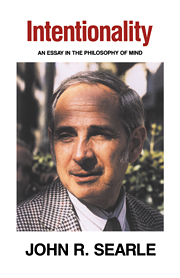Book contents
- Frontmatter
- Contents
- Acknowledgements
- Introduction
- 1 The nature of Intentional states
- 2 The Intentionality of perception
- 3 Intention and action
- 4 Intentional causation
- 5 The Background
- 6 Meaning
- 7 Intensional reports of Intentional states and speech acts
- 8 Are meanings in the head?
- 9 Proper names and Intentionality
- 10 Epilogue: Intentionality and the brain
- Subject index
- Name index
7 - Intensional reports of Intentional states and speech acts
Published online by Cambridge University Press: 05 June 2012
- Frontmatter
- Contents
- Acknowledgements
- Introduction
- 1 The nature of Intentional states
- 2 The Intentionality of perception
- 3 Intention and action
- 4 Intentional causation
- 5 The Background
- 6 Meaning
- 7 Intensional reports of Intentional states and speech acts
- 8 Are meanings in the head?
- 9 Proper names and Intentionality
- 10 Epilogue: Intentionality and the brain
- Subject index
- Name index
Summary
In Chapter 1, I made a distinction between Intentionality-with-a-t and intensionality-with-an-s. Though Intentionality is a feature of both speech acts and mental states and intensionality is a feature of some mental states and some speech acts, there is a clear distinction between the two. I have further argued that it is a mistake to confuse features of reports of Intentional states with features of the Intentional states themselves, and in particular it is a mistake to suppose that because reports of Intentional states are intensional-with- an-s that Intentional states themselves must be intensional-with- an-s. This confusion is part of a more pervasive and fundamental confusion, namely, the belief that we can analyze tne character of Intentionality solely by analyzing the logical peculiarities of reports of Intentional states. I believe on the contrary that it betrays a fundamental confusion if we try to get clear about Intentionality by analyzing intensionality. It is important to keep in mind that there are at least three different sets of questions about Intentional states and about how they are reported in utterances of intensional sentences: first, what are the features of the Intentional states? (Chapters 1–3 were devoted to discussing this question); second, how are those features represented in ordinary speech? (this chapter is mostly concerned with this question); and third, how can we best represent these features in a formalized system such as the predicate calculus? (If you can get clear about the answers to the first two questions, the third is considerably easier.)
- Type
- Chapter
- Information
- IntentionalityAn Essay in the Philosophy of Mind, pp. 180 - 196Publisher: Cambridge University PressPrint publication year: 1983



